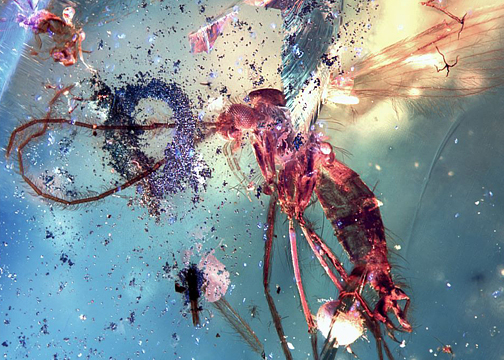Abstract
Bruchomyiinae is a small subfamily of moth flies (Psychodidae) which includes fewer than 60 species restricted to tropical and subtropical regions (Curler & Jacobson, 2012; Wagner & Stuckenberg, 2016; Wagner, 2017; Skibińska & Santos, 2023). Despite their low species diversity, representatives of this subfamily are relatively common in the fossil record. To date, 28 fossil species across five genera have been identified. All known fossil representatives are preserved as inclusions in various fossil resins, ranging in age from Lower Cretaceous Lebanese amber (Azar et al., 2022) to Lower Miocene Dominican amber (Wagner, 2017). The genus Palaeoglaesum Wagner, 2017 is an extinct taxon known exclusively from Kachin amber, Myanmar. This genus comprises 15 species distributed in two subgenera: Palaeoglaesum (Palaeoglaesum) and Palaeoglaesum (Amplissimum) (Skibińska & Santos, 2023). This genus is the most diverse fossil representative of this subfamily. Diagnostic characters of Palaeoglaesum include a small body size (approximately 2‒2.5 mm), dense setation, a head with a median longitudinal strip of setae, elongate mouthparts with prominent labellum, and an oval wing with a broadly rounded apex. The vein R2+3 is at least twice as long as R2, and the radial fork is positioned distally to the medial fork. Male genitalia exhibit either an elongated, apically bifurcated aedeagus or a short, non-bifurcated form, both surrounded at the base by a sleeve-like parameral sheath (Skibińska et al., 2021; Skibińska & Santos, 2023). The high number of Palaeoglaesum species found in Kachin amber suggests that the tropical, near-coastal climate of the mid-Cretaceous Myanmar amber forest provided favorable conditions for a high diversity of Bruchomyiinae. Their ecology is closely associated with forest habitat, particularly tree hollows, forest litter, and tree trunks, which likely contributed to their frequent preservation in amber. The ongoing discoveries of new fossil taxa suggests that the diversity of Bruchomyiinae during the Cretaceous was likely much greater than it is today (Skibińska et al., 2019, 2023).
References
- Alexander, C.P. (1920) A new subfamily of tanyderid flies (Diptera). Annals of the Entomological Society of America, 13 (4), 402–406 + Plate XXXII. https://doi.org/10.1093/aesa/13.4.402
- Azar, D., Szwedo, J., Maalouf, M., Maalouf, R. & Maksoud, S. (2022) Libanonemopalpus grimaldii, a new genus and species of Bruchomyiinae from Lower Cretaceous Lebanese amber (Diptera: Psychodidae). Palaeoentomology, 5 (6), 569–578. https://doi.org/10.11646/palaeoentomology.5.6.7
- Cumming, J.M. & Wood, D.M. (2017) Adult morphology and terminology. In: Kirk-Spriggs, A.H. & Sinclair, B.J. (Eds), Manual of Afrotropical Diptera, Volume 1: Introductory chapters and keys to Diptera families. South African National Biodiversity Institute, Pretoria, pp. 89–133.
- Curler, G.R. & Jacobson, A.J. (2012) New species of Psychodidae (Diptera) from Australasia, with a checklist of the world species of Bruchomyiinae and Sycoracinae. Zootaxa, 3552 (1), 43–65. https://doi.org/10.11646/zootaxa.3552.1.3
- Krzemiński, W. & Krzemińska, E. (2003) Triassic Diptera: Descriptions, revisions, and phylogenetic relations. Acta Zoologica Cracoviensia, 46 (Suppl.), 153–184.
- Linnaeus, C. (1758) Systema naturae per regna tria naturae: Secundum classes, ordines, genera, species, cum characteribus, differentiis, synonymis, locis. Editio decima, reformata. Tomus I. Laurentius Salvius, Holmiae [= Stockholm], 824 pp. https://doi.org/10.5962/bhl.title.542
- Newman, E. (1834) Attempted division of British insects into natural orders. The Entomologist’s Monthly Magazine, 2, 379–431.
- Skibińska, K. & Santos, D. (2023) New subgenus and two new species of the genus Palaeoglaesum and its position within Bruchomyiinae (Psychodidae). Acta Zoologica Cracoviensia, 66 (1-2), 1–18. https://doi.org/10.3409/azc.66.01
- Skibińska, K., Albrycht, M., Zhang, Q.Q., Giłka, W., Zakrzewska, M. & Krzemiński, W. (2021) Diversity of the fossil genus Palaeoglaesum Wagner (Diptera, Psychodidae) in the Upper Cretaceous amber of Myanmar. Insects, 12 (3), 247. https://doi.org/10.3390/insects12030247
- Skibińska, K., Krzemiński, W. & Zhang, Q.Q. (2019) A revised diagnosis of Palaeoglaesum Wagner (Diptera, Psychodidae, Bruchomyiinae) with description of two new species from Cretaceous Myanmar amber. Historical Biology, 33 (2), 230–236. https://doi.org/10.1080/08912963.2019.1607321
- Skibińska, K., Zhang, Q.Q., Ševčík, J., Kopeć, K. & Krzemiński, W. (2023) Description of three new species of Palaeoglaesum Wagner (Diptera: Psychodidae, Bruchomyiinae) from mid-Cretaceous amber of northern Myanmar. Cretaceous Research, 152, 105676. https://doi.org/10.1016/j.cretres.2023.105676
- Stebner, F., Solórzano Kraemer, M.M., Ibáñez-Bernal, S. & Wagner, R. (2015) Moth flies and sand flies (Diptera: Psychodidae) in Cretaceous Burmese amber. PeerJ, 3, e1254. https://doi.org/10.7717/peerj.1254
- Wagner, R. (2017) Synopsis of extinct Bruchomyiinae (Diptera, Psychodidae) from Burmese, Baltic and Dominican amber, with description of a new genera and species. Zootaxa, 4320 (1), 100–120. https://doi.org/10.11646/zootaxa.4320.1.6
- Wagner, R. & Stuckenberg, B. (2016) Cladistic analysis of Subfamily Bruchomyiinae (Diptera: Psychodidae). Zootaxa, 4092 (2), 151–174. https://doi.org/10.11646/zootaxa.4092.2.1


